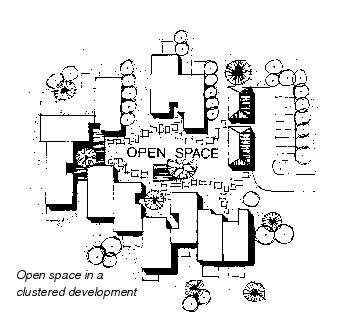20D.110.10 Open Space.
20D.110.10-010 Purpose.
The purpose of this section is to implement the Open Space Plan and Policies of RCDG Title 20B, Goals, Policies and Plans. (Formerly 20C.20.130(05))
20D.110.10-020 Regulations for Designated Open Space.
The following regulations shall apply to all areas designated “Open Space” in RCDG Title 20B, Parks, Recreation, and Open Space Plan:
(1) Activities which would remove significant amounts of vegetation, alter land forms, or have other adverse effects on the environment shall be prohibited in designated open space areas.
(2) Development in designated open space areas may be clustered, but the clustering shall not exceed a density of one dwelling unit per acre.
(3) Structures placed or constructed in open space area shall be designed and sited to cause the least possible disturbance to the surrounding environment. This may be achieved through the use of natural or rustic building materials, designs and colors which harmonize with the surrounding environment; the use of existing vegetation as a buffer to avoid visual and other impacts; the use of innovative and sensitive site design to minimize short- and long-term manmade disturbance to the site; or by any other means. (Formerly 20C.20.130(10))
20D.110.10-030 Types of Open Space.
(1) Purpose. Types of open space form a hierarchy of which conservation open space is of greatest importance in site design with amenity and recreation open space following.
(2) Conservation Open Space. Unique resource areas where plants, animals, water, air and soil have been left in an undisturbed state or areas of historical value. Such open space may consist of, but not be limited to, wetlands, watercourses, rivers, lakes, ponds, flood zones, ravines, steep slopes, wooded areas and wildlife areas.
(3) Amenity Open Space. Undeveloped land and natural features worthy of preservation primarily for their scenic or aesthetic value and landscape areas. Such open space may consist of, but not be limited to, wooded areas, agricultural land, open valley floors, pastures and fields, parks, landscaped right-of-way, buffer areas, and all manner of landscape areas such as courtyards, gardens, lawn and shrub-areas.
(4) Recreation Open Space. Recreation areas and facilities that meet recreation needs of City residents. Such open space may consist of, but shall not be limited to, parks, walkways, bikeways, trails, sitting areas, para-courses, golf courses, tot-lots, recreation buildings, and outdoor activity areas such as tennis, basketball and sport courts and swimming pools. (Formerly 20C.20.130(15))
20D.110.10-040 Design Requirements.
The following shall apply to all new developments:
(1) The open space required by RCDG 20C.60.25, Site Requirements, shall be provided.
(2) Open space within a development shall be available for common use by the residents, tenants and/or the general public, depending on the type of project. The open space may be used for recreation, waterfront access; landscaping; visual, noise or land use buffer; drainage control; or other purposes the City may approve during project review and approval that are consistent with the definition of open space.
(3) Required open space within all new developments shall be designed by using the criteria of Chapter 20D.40 RCDG, Design Standards, paragraph titled “Open Space”. (Formerly 20C.20.130(20))
20D.110.10-050 Open Space Disposition and Maintenance.
The disposition and maintenance of required open space shall be accomplished at the discretion of City by using any of the following methods:
(1) The City may obtain fee simple ownership of the land and assume total maintenance and liability; or
(2) The City and property owner(s) may enter into an easement agreement to retain and maintain the open space; or
(3) The open space land may be held in common and maintained by the property owner(s) or the maintenance may be contracted to another person(s)/agency; or
(4) The open space land may be owned and maintained by a homeowners association; or
(5) The open space may exist due to a plat or deed restrictions with maintenance being performed by the landowners, the tenants or the City; or
(6) The open space may be dedicated to another appropriate agency, such as the state, county, special district or other jurisdiction who would own and maintain the open space property; or
(7) The open space could be held and maintained through several combinations of the above or by other arrangement that achieves the purpose of this section and is acceptable to the City; or
(8) The developer may request the City to accept a fee in lieu of dedicating all or part of the required open space with approval or denial by the City Council after a preliminary recommendation by the Technical Committee; or
(9) The City may accept a comparable piece of property as open space in lieu of providing open space within a development; or
(10) The City may require that a fee in lieu of dedication of open space be provided. (Formerly 20C.20.130(25))
20D.110.10-060 Fee-in-Lieu-of Open Space Program.
To be developed later on fee basis, use of fee, location of fee, fund control. (Formerly 20C.20.130(30))


